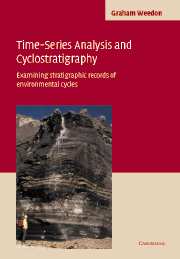Book contents
- Frontmatter
- Contents
- Preface
- Acknowledgements
- Chapter 1 Introduction
- Chapter 2 Constructing time series in cyclostratigraphy
- Chapter 3 Spectral estimation
- Chapter 4 Additional methods of time-series analysis
- Chapter 5 Practical considerations
- Chapter 6 Environmental cycles recorded stratigraphically
- Appendix – published algorithms for time-series analysis
- References
- Index
Chapter 1 - Introduction
Published online by Cambridge University Press: 13 August 2009
- Frontmatter
- Contents
- Preface
- Acknowledgements
- Chapter 1 Introduction
- Chapter 2 Constructing time series in cyclostratigraphy
- Chapter 3 Spectral estimation
- Chapter 4 Additional methods of time-series analysis
- Chapter 5 Practical considerations
- Chapter 6 Environmental cycles recorded stratigraphically
- Appendix – published algorithms for time-series analysis
- References
- Index
Summary
Cyclostratigraphic data
Increasingly, quantitative records of environmental change covering intervals of between half a day to millions of years are being sought by palaeoceanographers, environmental scientists, palaeoclimatologists, sedimentologists and palaeontologists. The ‘media’ from which these records are obtained range from sediments and sedimentary rocks to living organisms and fossils showing growth bands (especially trees, corals and molluscs), ice cores and cave calcite. This book is concerned with explaining the quantitative methods that can be employed to derive useful information from these records. Much of the discussion is concerned with explaining the problems and limitations of the procedures and with exploring some of the difficulties with interpretation. Most frequently environmental records are obtained from sedimentary sections making up the stratigraphic record and, using a rather broad definition, all the ‘media’ described above are ‘stratigraphic’. The nature of cycles in environmental signals and in stratigraphic records are explored later. However, for now cycles can be thought of as essentially periodic, or regular, oscillations in some variable. The study of stratigraphic records of environmental cycles has been called cyclostratigraphy (Fischer et al., 1990).
By regarding stratigraphic records of environmental change as signals, it is clear that the methods and interpretations reached during analysis must allow for the imperfections inherent in all recording procedures. In cyclostratigraphic data the environmental signal, which is ‘encoded’ during sedimentation, is often corrupted to some extent by interruptions caused by processes that are not part of the normal depositional system.
Information
- Type
- Chapter
- Information
- Time-Series Analysis and CyclostratigraphyExamining Stratigraphic Records of Environmental Cycles, pp. 1 - 20Publisher: Cambridge University PressPrint publication year: 2003
Accessibility standard: Unknown
Why this information is here
This section outlines the accessibility features of this content - including support for screen readers, full keyboard navigation and high-contrast display options. This may not be relevant for you.Accessibility Information
- 4
- Cited by
